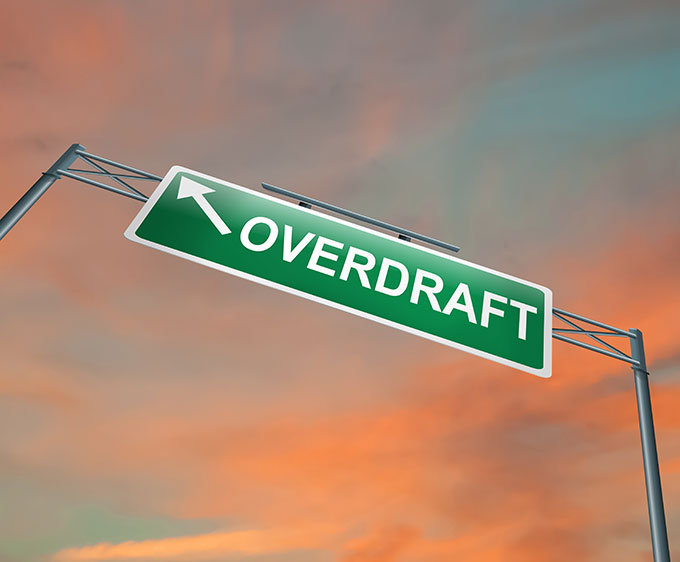When you walk into your local bank or credit union to open a checking account, the staff will no doubt recommend a variety of additional financial services. However, this is not merely a matter of offering better, and more extensive, services for their customers. True, it's in the bank's best interest to provide a full range of financial products and services in order to attract, and maintain, a healthy clientele. But these services are also a major source of income, and when it comes down to it your bank is usually thinking more about their bottom line than they are about yours.
One of the services you will be encouraged to sign on for is 'Overdraft Protection', a popular feature attached to many mid-tier and upper-tier checking accounts. Overdraft protection offers some very real benefits to the customer, but those benefits come at a cost. Before you opt-in to an overdraft protection plan, it is important to fully understand the program and the potential pitfalls.

An overdraft occurs when you write a check, make a debit card purchase, or authorize an automatic bill payment for an amount of money that exceeds the current balance of your checking or savings account. In effect, an overdraft takes your account into a negative balance, leading to checks being returned and transactions being refused due to 'non-sufficient funds' (NSF).
There are three basic ways in which a bank may treat an overdraft – No Protection, Overdraft Forgiveness, and Overdraft Protection. 'No Protection' is the default position for most banks, and while you may be offered overdraft forgiveness or protection, it is up to you whether or not you sign on for the service. To help you make your decisions, a brief overview of each method is in order.
In 2013 a Pew Charitable Trust study found that 10% of adults with checking accounts paid at least one overdraft fee & another 5% paid and overdraft transfer fee. These penalties amounted to an estimated $32 billion in fees in 2012. Consumers who plan their budgets and create a safety fund can easily avoid these expensive fees.
When you enroll in overdraft protection, your bank will use one of two methods when transferring funds from a secondary account to your primary checking account. Each has its advantages and disadvantages, and it's worth noting the differences between the two policies if you are going to make an informed decision about whether or not to opt-in to an overdraft protection plan.
Banks typically favor one overdraft model, and you may not have a choice in how your overdraft protection plan is managed. Before you sign up for an overdraft protection service it is important that you understand how the necessary transfers will be handled, and how your bank will calculate the transfer fees.
We've already touched on the primary fees associated with overdraft protection. These are the fees your bank charges each time they transfer funds from your linked source to cover an overdraft. However, there are some additional fees and charges you should be aware of before you opt-in to an overdraft protection plan.
These additional charges vary from bank to bank, so it is vital that you fully understand how your bank manages its overdraft protection services before you sign up for the program. Fortunately, Federal law requires that all banks and credit unions fully disclose how their overdraft protection services are managed, and how fees are assessed and applied. However, it is up to you as a customer to read the fine print.

The chief advantage of signing on for overdraft protection is that your checking account will never slip into a negative balance. Your checks will never bounce and your debit card transactions will never be rejected (assuming, of course, that you do not overtax your linked accounts). This can be more than simply a convenience, particularly in an emergency; and while overdraft protection comes with a price, that cost is usually significantly cheaper than racking up fees for non-sufficient funds (NSF) and returned checks. Moreover, when it comes to bouncing checks there's more to consider than just the financial ramifications, which in themselves can be significant. The party you wrote the bad check to can not only charge you a returned check fee, they can also report you to a consumer credit reporting agency like ChexSystems. This can lead to vendors refusing your checks, banks refusing to allow you to open new accounts, and your current accounts being frozen or terminated.
While there are many advantages to having overdraft protection, there is a downside. The ways in which banks order transactions and determine overdraft fees can be confusing to the layman, and it can be hard to predict when and how overdraft fees will be imposed. This can lead to excessive fees that negate the value of having an overdraft protection plan in place. Overdraft protection also makes it all too easy to mismanage your money. Without overdraft protection, you are forced to pay stricter attention to your bank balance if you want to avoid bouncing checks or having your debit card transactions rejected. The fear of a negative balance helps to keep spending in check, while the convenience of overdraft protection can adversely impact your ability to save money and live within your means.
Federal guidelines restrict banks from enrolling customers in overdraft protection plans without their express consent. Banks must fully disclose all aspects of their overdraft protection services, including all associated fees, charges and penalties, before the customer enrolls in the program. Customers also have the right to opt out of an overdraft protection plan at any time, without fear of penalty or reprisal. Remember, banks profit significantly from overdraft fees, and it is your right as a consumer to opt-in, or opt out, of any overdraft protection plan as you see fit.
In the final analysis, the most effective overdraft protection is you. Knowing how to manage your money, and keeping a watchful eye on your bank balance, will help to keep your accounts from slipping into the red. However, should you decide to opt-in to your bank's overdraft protection service, there are a few things you can do to avoid falling prey to excessive overdraft fees.
These basic tips really apply to everyone, regardless or whether or not you are enrolled in an overdraft protection plan. Following these rules will help you to avoid bouncing checks, or having your debit card purchases rejected for lack of funds. However, if you have signed on for an overdraft protection plan, these tips will help minimize your risk for any unexpected, or excessive, overdraft fees.
Overdraft protection can be a valuable service, particularly in an emergency. But make no mistake, banks do not offer overdraft protection merely as a courtesy to their customers. Banks are ever mindful of their own bottom lines, and overdraft fees are a significant source of their income. They're happy to offer overdraft protection services, because each transaction means more money in their coffers. Before you enroll in your bank's overdraft protection plan, be certain that you understand what you are signing on for. Read the contract fully, paying close attention to the small print. Take nothing at face value, and ask your bank's representative to explain any part of the program that you find confusing. Remember, overdraft protection can be a valuable service, but it can also easily lead to excessive fees that put your own bottom line at risk.
The Federal Reserve has hinted they are likely to taper their bond buying program later this year. Lock in today's low rates and save on your loan.
Are you paying too much for your mortgage?
Check your refinance options with a trusted El Monte lender.
Answer a few questions below and connect with a lender who can help you refinance and save today!